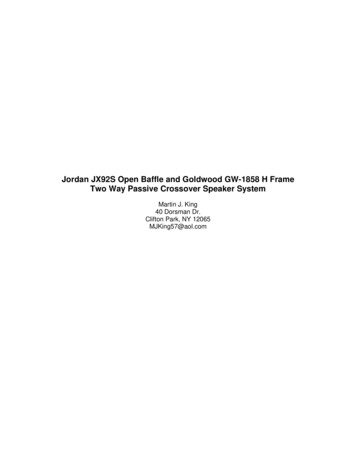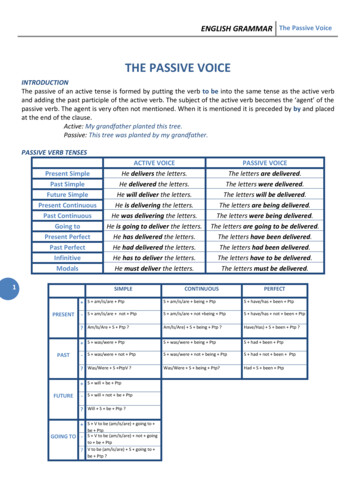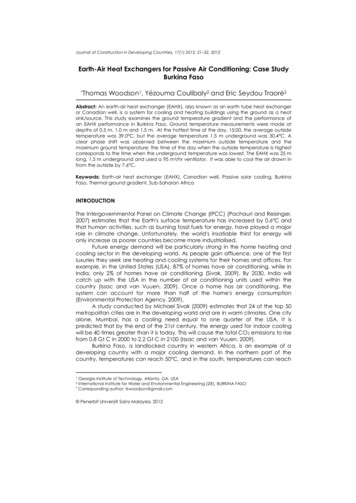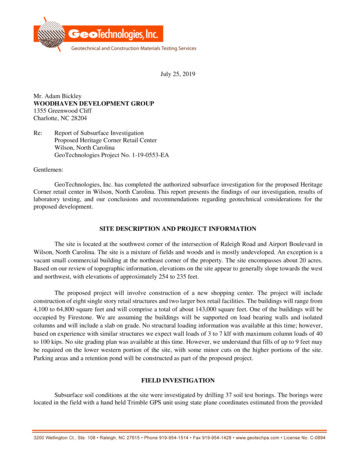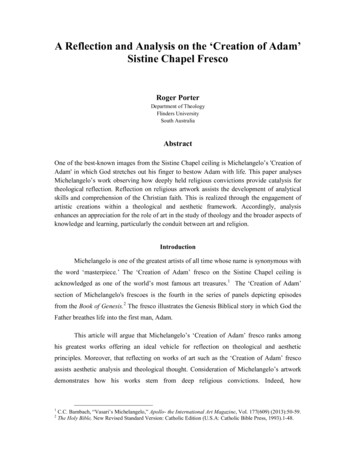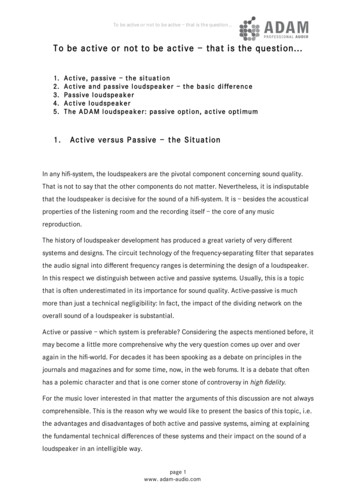
Transcription
To be active or not to be active – that is the question.T o be ac tive or not to be ac tive – that is the question.1.2.3.4.5.1.A c t i ve, pa ssi ve – t he si t ua t i onA c t i ve a nd pa ssi ve l oudspea k er – t he ba si c di fferenc ePa ssi ve l oudspea k erA c t i ve l oudspea k erT he A D A M l oudspea k er: pa ssi ve opt i on, a c t i ve opt i mumAc t ive ver sus P assive – t he S it uat ionIn any hifi-system, the loudspeakers are the pivotal component concerning sound quality.That is not to say that the other components do not matter. Nevertheless, it is indisputablethat the loudspeaker is decisive for the sound of a hifi-system. It is – besides the acousticalproperties of the listening room and the recording itself – the core of any musicreproduction.The history of loudspeaker development has produced a great variety of very differentsystems and designs. The circuit technology of the frequency-separating filter that separatesthe audio signal into different frequency ranges is determining the design of a loudspeaker.In this respect we distinguish between active and passive systems. Usually, this is a topicthat is often underestimated in its importance for sound quality. Active-passive is muchmore than just a technical negligibility: In fact, the impact of the dividing network on theoverall sound of a loudspeaker is substantial.Active or passive – which system is preferable? Considering the aspects mentioned before, itmay become a little more comprehensive why the very question comes up over and overagain in the hifi-world. For decades it has been spooking as a debate on principles in thejournals and magazines and for some time, now, in the web forums. It is a debate that oftenhas a polemic character and that is one corner stone of controversy in high fidelity.For the music lover interested in that matter the arguments of this discussion are not alwayscomprehensible. This is the reason why we would like to present the basics of this topic, i.e.the advantages and disadvantages of both active and passive systems, aiming at explainingthe fundamental technical differences of these systems and their impact on the sound of aloudspeaker in an intelligible way.page 1www. adam-audio.com
To be active or not to be active – that is the question.2.Ac t ive und passive loudspeaker – t he basic Differ enc eGenerally speaking, active and passive loudspeaker systems are different in respect to theamplifying and the crossover network. Active systems (in the strict sense of the word) have abuilt-in amplifier and an electronic dividing network whereas passive systems are driven byan external receiver or power amplifier and have a passive frequency-separating filter. Thatmeans:a)A passive system amplifies – necessary for the transformation into sound waves –the music signal externally whereas an active system has integrated amplifiersections.This difference brings about differences concerning the design of active and passiveloudspeakers. The most crucial aspect is the succession of amplification and frequencyseparation of the filter(s). That means, the second important difference concernsb)the design (construction) and the parts employed in the crossover network.Before we address these aspects in more detail we can pin down that active/passive is nota marginal feature of loudspeakers but an alternative of principle nature in terms ofamplification and crossover network.page 2www. adam-audio.com
To be active or not to be active – that is the question.3.P assive Loudspeaker Syst emsPassive Systems still dominate the world of hifi. This predominance has many reasons ofwhich the following two are the most important ones in regard of our topic: On the one hand, the occasional susceptible active electronics and, on the other hand, the fact that there have been only a very few convincing agents of thiskind on the market which could live up to the promise of technical superiority.But how do passive systems basically work and what are the problems with this technology?3.1Const ruc t i on of a pa ssi ve l oudspea k erFor the transformation of the audio signals into sound waves, passive loudspeakers requirean external power amplifier. That means that the loudspeaker gets a signal that already hasbeen amplified and is many times ‘bigger’ than the original signal.In the loudspeaker, this signal hits the (passive) crossover network that divides it up into thedifferent frequency bands.Figure 1: passive crossover networkThe massive components (spoolings, condensers, etc.)are obvious at first glance, especially when comparedto an electronic crossover network (see fig. 3).Having been divided into these different bands, the electrical signals are being sent to thecorresponding drivers, which transform them into mechanical vibration, i.e.: sound waves.Now, the crucial point here is the downspout of amplification, split-up, and distribution ofthe audio signal, to put it simply: Where and when happens what to the signal? Figure 2visualizes the way of the signal: First comes the amplification, then the split-up into thedifferent bands, and finally the transmission to the driver.page 3www. adam-audio.com
To be active or not to be active – that is the question.Figure 2: Schematic representation of thesignal’s run in a passive three way loudspeakerThe original audio signal is amplified (bold lines)and separated into high (high pass), middle(band pass), and low (low pass) frequencies. Thenthe signal is forwarded (dashed lines) to thecorresponding driver that transforms it into soundwaves and radiates them.3.2D i sa dva nt a g es of pa ssi ve syst emsIt is exactly this progression of the signal described above that causes the main problem ofpassive loudspeakers (compared to active): Generally, the high signal streams require massive components of the frequencyseparating filters. These massive components inevitably cause distortions andphase shifts. To put it differently: Exactly because the original signal is beingamplified before it reaches the crossover network, its components (resistors,spoolings, condensers, etc.) have to be quite voluminous to be capable towithstand the amperage. So, a st rong si gna l hi t s st rong resi st a nc es.Inesc a pa bl y, t hi s si g na l wi l l be i mpa i red a nd di st ort ed. The most important specific deprivation caused by passive filters is the so-called‘damping factor’. This factor indicates the precision with which an amplifier is ableto control the movements of the membranes (of the drivers). A bad damping factormeans that the amplifier is not capable of controlling (the vibrations of) themembrane(s) in an exact way. Distortions concerning the sound are inevitable. Upto date high-class amplifier achieve excellent damping factors – but the passivecrossover network impairs this factor drastically. To put it simple: In pa ssi vel oudspea k ers, t he frequenc y-sepa ra t i ng fi l t ers a re l oc a t ed i nbet ween t he a mpl i fi c a t i on a nd t he dri ver uni t s a nd nec essa ri l y c a usea l oss of prec i si on wi t h whi c h t he a mp c a n c ont rol t he dri vers.The best (and therefore quite expensive) crossover networks available today can reduce thisimpairment but never avoid it. Even the best ones diminish the damping factor drastically,on average down to five (yes, 5!) percent of the original value!page 4www. adam-audio.com
To be active or not to be active – that is the question.4.Ac t ive loudspeaker sDue to their different construction, active systems are able to avoid the problems explainedabove. They can process the electrical signal much more efficiently and almost losslessbefore it is being sent to the single driver.But how do active systems basically work and are there any other problems with thistechnology?4.1D esi g n of a n a c t i ve spea k erThe crossover network of active systems gets the electrical signal directly from the musicsource (e.g. CD-Player, preamplifier, etc.) and therefore does not need massive componentsto withstand high currents.figure 3: active (electronical) crossover networkA comparison with a passive filter (see fig. 1) makesthe differences become evident.Since the electronical signal is very weak and the components of the network do notsubtend any considerable resistance to the signal, it can be split-up with almost no loss orany kind of impairment. Within the realm of their frequency bands, the signals now reachtheir own amplifier. They are amplified and sent to the corresponding driver. That means,that each driver gets an almost loss-free electrical signal that it now has to transform intomechanical vibrations.Figure 4: Schematic representation of thesignal’s run in an active three way loudspeakerThe original audio signal is sent directly (dashed lines)to the electronic crossover network and separatedinto high (high pass), middle (band pass), and low(low pass) frequencies. An own amp thenamplifies ‘his’ frequency range. Finally, this signal issent (bold lines) to the driver.page 5www. adam-audio.com
To be active or not to be active – that is the question.So, each driver has its own power amplifier. The loss-free processing of the signals and thedirect coupling of driver and amplifier result in an optimal damping factor, so the amp hasperfect control over the driver. This means that a fundamental problem of all passivespeakers can be avoided and the aim of authentic music reproduction approaches.4.2D i sa dva nt a g es of a c t i ve syst ems?So how about possible problems of active loudspeaker systems? One hears respectivelyreads of mainly two objections: On the one hand the alleged susceptibility to damage of theactive electronics, on the other hand higher costs.The latter one is simply a prejudice although a very obstinate prejudice that has beenpassed on over decades. There are differences concerning specific models, of course. But ingeneral, an active speaker system is not more – rather less! – expensive than a set ofpassive loudspeakers and adequate external amplifiers. The point is not to compare applesand oranges but systems of assimilable quality.The mentioned susceptibility, however, is a different matter and a point that one has to takeserious. It is a fact that in the past some active systems did show technical problems. Themain reasons for that were deficient amplifier designs and strong heat development.Especially with bigger systems this heat could cause problems because it made the systemsusceptible do different kinds of damage and diminished the durability.This problem has been tackled by the development of new amplifier technologies. ADAMsPWM (Pulse Width Modulation) amplifiers have an extremely high efficiency of more than90%. That means they produce only one fifth of earlier A/B amplifiers. Due to substantialprogress in components and circuit technology excellent power amplifiers became possiblewhich belong to the absolute top class concerning technical data as well as sound quality.So, the one and only serious problem of active speaker systems could have been solved.What remains is a distinct superiority concerning both technical aspects and the soundquality.page 6www. adam-audio.com
To be active or not to be active – that is the question.5.ADAM loudspeaker s: passive opt ion, ac t ive opt imumWhich system is to be preferred – an active or a passive loudspeaker? In the professionalaudio world, this question has been answered a long time ago decidedly in favor of activesystems. Accordingly, this question is not posed anymore in the professional area. Thesuperiority of active systems has not only been theoretically but also practically proved.Nevertheless, in the world of hifi passive system are still predominant. It would go beyondthe realm of this text to speculate about the reasons concerning habits, the market andalike. Without any doubt one can achieve good results with passive loudspeakers if the hificomponents (and the loudspeakers in particular) are of the appropriate quality. That is themain reason why ADAM offers hifi speakers as passive (or semi active) versions, too. Ouractive technology is an important feature but only one of many features, which areresponsible for the outstanding sound quality they are famous for. This allows any musiclover who does not want to relinquish his own amplifier(s) to enjoy the ADAM sound.We are, however, convinced of the advantages of active loudspeakers. Due to our farreaching experience in the production of active studio monitors and our proprietarytransducer technology we are able to offer loudspeakers that avoid earlier problems ofactive systems. We have developed many both passive and active models and thus have awealth of experiences in that matter. Over and over again we found that despite similaroverall sound the active versions always showed advantages concerning the precision andthe resolution of the sound.Truly, we are not alone in advocating active systems. To give you only one example amongstmany more, the eminently respectable German magazine image hifi writes:“ refrain from the baublery with power amplifiers and loudspeaker cables. Thuswith active configurations alone one can expand into the very best reproduction ofmusic. No driver, as perfect as it may be, can give back what the passive crossovernetwork takes away from the signal.” (02/2001)Active or passive? At the end of the day it is one’s own ear, it is one’s own taste that decides– and there’s (no) accounting for taste. If, however, one takes the technical and acousticalfacts serious, this decades-long question would need to be rephrased: why still passive atall?page 7www. adam-audio.com
To be active or not to be active – that is the question. Copyright 2007 ADAM Professional Audio (www.adam-audio.com). All rights resevered. Ifyou use this text and/or the figures in any way, please make sure you clearly indicate its origin.page 8www. adam-audio.com
4.1 Design of an active speaker The crossover network of active systems gets the electrical signal directly from the music source (e.g. CD-Player, preamplifier, etc.) and therefore does not need massive components to withstand high currents. figure 3: active (electronical) crossover network A comparison with a passive filter (see fig. 1) makes



